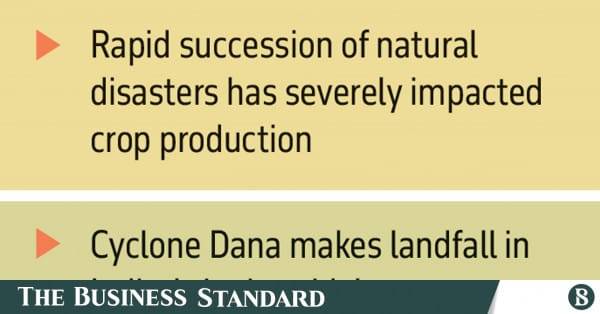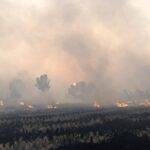Main Points In Hindi (मुख्य बातें – हिंदी में)
-
प्राकृतिक आपदाओं का प्रभाव: बांग्लादेश के दक्षिणी और दक्षिणपूर्वी क्षेत्रों में हाल की बाढ़ों के बाद, चक्रवात दाना का खतरा बढ़ गया है, जिससे देश की कृषि उत्पादन, विशेषकर चावल और सब्जियों पर गंभीर प्रभाव पड़ने की संभावना है।
-
चक्रवात दाना का आगमन: चक्रवात दाना ने भारत के ओडिशा तट पर दस्तक दी है और इसके कारण बांग्लादेश के तटीय जिलों में ज्वार-भाटा और भारी वर्षा होने की संभावना है, जिससे खेतों में फसलों को नुकसान पहुँच सकता है।
-
कृषि पर प्रभाव: बीएमडी (बांग्लादेश मौसम विज्ञान विभाग) के अनुसार, चक्रवात के कारण शक्तिशाली हवाएँ और अत्यधिक वर्षा हो सकती हैं, जिससे निचले तटीय इलाकों में बाढ़ की स्थिति उत्पन्न हो सकती है। इससे पहले से प्रभावित क्षेत्रों में पहले से बोई गई फसलों को और नुकसान हो सकता है।
-
खाद्य असुरक्षा और बाजार प्रभाव: बाढ़ के कारण कृषि उत्पादन में भारी कमी आई है, जिससे चावल और सब्जियों की कीमतों में तेजी आई है। लगभग 38% गरीब परिवारों ने खाद्य असुरक्षा का अनुभव किया है, और सरकार ने इस समस्या का समाधान करने के लिए आयात शुल्क कम किया है।
- पिछले प्राकृतिक आपदाओं का संदर्भ: हाल के महीनों में बांग्लादेश में कई गंभीर बाढ़ और चक्रवात आए हैं, जिससे व्यापक जन जीवन प्रभावित हुआ है। पिछली घटनाओं के दौरान, लाखों लोग आपातकालीन केंद्रों में शरण लेने के लिए मजबूर हुए थे और बड़े पैमाने पर फसल उत्पादन को नुकसान पहुँचा था।
Main Points In English(मुख्य बातें – अंग्रेज़ी में)
Here are the main points from the text about the impact of cyclone "Dana" and the recent floods in Bangladesh:
-
Current Natural Disasters: Bangladesh is recovering from two recent floods, and the coastal regions are now preparing for the impact of cyclone "Dana," which is expected to cause significant rainfall and tidal surges in 14 coastal districts.
-
Agricultural Threats: The sequence of natural disasters has posed a serious threat to the production of various crops, including rice, vegetables, and early potatoes. Continuous heavy rains may lead to significant losses for Aman rice and other crops.
-
Warnings and Preparedness: The Bangladesh Meteorological Department has raised local warning signals and has predicted heavy rainfall and strong winds due to the cyclone, potentially leading to flooding in low-lying coastal areas.
-
Economic Impact: The floods have already resulted in considerable crop losses, leading to a rise in rice prices. The government has responded by reducing import duties on rice to mitigate the price increase and ensure food security.
- Food Insecurity: Ongoing natural disasters have exacerbated food insecurity, with a significant portion of low-income families struggling to afford food. Reports indicate that many families are borrowing money to buy food due to rising prices.


Complete News In Hindi(पूरी खबर – हिंदी में)
चूँकि बांग्लादेश के दक्षिणी और दक्षिणपूर्वी क्षेत्र लगातार दो बाढ़ों से उबरने के लिए संघर्ष कर रहे हैं, तटीय क्षेत्र अब चक्रवात दाना के प्रभाव के लिए तैयार हो रहे हैं।
प्राकृतिक आपदाओं के इस तीव्र क्रम ने चावल, सब्जियों और शुरुआती आलू सहित सभी फसलों के उत्पादन को गंभीर खतरे में डाल दिया है।
चक्रवात दाना ने कल रात 10 बजे के आसपास भारत के ओडिशा तट पर दस्तक देनी शुरू कर दी। इसके प्रभाव से बांग्लादेश के 14 तटीय जिलों में ज्वार-भाटा आ सकता है और देश के अन्य क्षेत्रों में भारी वर्षा हो सकती है। ये बारिश 26 अक्टूबर तक जारी रह सकती है.
अगर दो-तीन दिनों तक भारी बारिश होती रही तो खेतों में लगे अमन चावल और विभिन्न प्रकार की सब्जियों को काफी नुकसान होने की आशंका है.
बांग्लादेश मौसम विज्ञान विभाग (बीएमडी) ने सभी समुद्री बंदरगाहों को स्थानीय चेतावनी संकेत संख्या तीन बढ़ाने की सलाह दी है।
बीएमडी ने यह भी चेतावनी दी कि, तूफान के कारण, उत्तरी खाड़ी, अपतटीय द्वीपों, चार्स और बांग्लादेश के तटीय क्षेत्रों में भारी (44-88 मिमी) से बहुत भारी (>89 मिमी) वर्षा और तेज़ हवाएँ हो सकती हैं।
चक्रवात के केंद्र के पास अधिकतम निरंतर हवा की गति लगभग 90 किमी प्रति घंटे है, झोंके संभावित रूप से 110 किमी प्रति घंटे तक पहुंच सकते हैं। तूफान के केंद्र के पास समुद्र अशांत रहेगा।
तूफान और तेज दबाव परिवर्तन के कारण, तटीय जिलों के निचले इलाकों के साथ-साथ उनके अपतटीय द्वीपों और चरस में सामान्य ज्वार के स्तर से 2-3 फीट ऊपर हवा के कारण बाढ़ आने की संभावना है।
कृषि अधिकारियों के अनुसार, लगातार दो बाढ़ के कारण कई क्षेत्रों में शीतकालीन सब्जियों की खेती में पहले ही देरी हो चुकी है। यदि भारी बारिश जारी रही तो उन फसलों के लिए चिंताएं हैं जो पहले ही बोई जा चुकी हैं।
इस बारिश से उन लोगों के लिए बुआई में भी देरी होगी जो सब्जियां उगाने की योजना बना रहे हैं। इसके अतिरिक्त, रंगपुर डिवीजन में आलू की शुरुआती खेती महत्वपूर्ण जोखिम में है।
तटीय क्षेत्रों में अमन चावल की खेती को भी ख़तरे का सामना करना पड़ रहा है। तूफान और भारी बारिश से इन क्षेत्रों में अमन चावल के उत्पादन को गंभीर नुकसान हो सकता है।
कल, खेपुपारा में सबसे अधिक 98 मिमी बारिश दर्ज की गई, इसके बाद 24 घंटों में बारिशाल में 63 मिमी, पटुआखली में 73 मिमी, कुमिला में 48 मिमी, मदारीपुर में 44 मिमी और ढाका में 16 मिमी बारिश दर्ज की गई।
बीएमडी के मौसम विज्ञानी अबुल कलाम मल्लिक ने टीबीएस को बताया, “बांग्लादेश को अब चक्रवात दाना से कोई खतरा नहीं है, लेकिन इसके प्रभाव से तटीय क्षेत्रों और देश के अन्य हिस्सों में आज (कल) भारी बारिश हुई है।”
“चक्रवात के कारण तटीय क्षेत्रों में हवा के झोंके भी आ सकते हैं, जिसके परिणामस्वरूप सामान्य से अधिक ऊंचे ज्वार आ सकते हैं। यह बारिश शुक्रवार तक जारी रहने की उम्मीद है और शनिवार को इसमें कमी आनी शुरू होनी चाहिए।”
इस बीच, कृषि मंत्रालय की एक रिपोर्ट से पता चलता है कि अगस्त में आई बाढ़ ने 13 जिलों में अमन चावल की खेती को नष्ट कर दिया है। इससे औस और अमन चावल के उत्पादन में लगभग 11 लाख टन का नुकसान हुआ है। बाढ़ के दो चरणों के कारण फसल उत्पादन में औसतन लगभग 14.5% की हानि हुई है।
परिणामस्वरूप, बाजार में चावल की कीमत कई मामलों में कम से कम Tk7 तक बढ़ गई है, जिससे सरकार को इस मुद्दे के समाधान के लिए आयात की योजना बनानी पड़ी है। सरकार पहले ही सरकारी और निजी आयात दोनों के लिए आयात शुल्क कम कर चुकी है।
राष्ट्रीय राजस्व बोर्ड की एक अधिसूचना के अनुसार, चावल पर आयात शुल्क 25% से घटाकर 15% कर दिया गया है। नियामक शुल्क 25% से घटाकर 5% कर दिया गया है, और 5% अग्रिम कर पूरी तरह से हटा दिया गया है। इससे प्रति किलोग्राम आयातित चावल पर कम से कम Tk14.40 की बचत होगी।
इसके अलावा, बाढ़ के दो चरणों के कारण 2 लाख टन सब्जी उत्पादन का नुकसान हुआ, जिससे बाजार में अधिकांश सब्जियां अप्राप्य हो गईं। इस समस्या से निपटने के लिए सरकार ने ढाका में कम कीमत पर सब्जियां बेचने का कार्यक्रम शुरू किया है।
संयुक्त राष्ट्र विश्व खाद्य कार्यक्रम (डब्ल्यूएफपी) के अनुसार, देश में कम आय वाले 38% परिवारों ने पिछले अगस्त में खाद्य असुरक्षा का अनुभव किया। इसके अतिरिक्त, 43% गरीब परिवार भोजन खरीदने के लिए पैसे उधार ले रहे हैं। चावल, सब्जियों और अन्य खाद्य पदार्थों की कीमतों में तेज वृद्धि इस समस्या का एक प्रमुख कारण है।
कृषि मंत्रालय के सचिव मोहम्मद इमदाद उल्लाह मियां ने टीबीएस को बताया, “हमने सभी कृषि विभाग के अधिकारियों को सतर्क रहने का निर्देश दिया है। आपदाओं के दौरान कुछ नुकसान की संभावना हमेशा बनी रहती है। हालांकि, हम किसी भी नुकसान से उबरने के लिए तुरंत कार्रवाई करने के लिए तैयार हैं।” दाना के कारण हुई क्षति।”
इस वर्ष की प्राकृतिक आपदा कैसी थी?
अक्टूबर के पहले सप्ताह में, शेरपुर जिले के कई उपजिलाओं के साथ-साथ मैमनसिंह जिले के क्षेत्रों में भारी वर्षा और पहाड़ी बाढ़ के कारण गंभीर बाढ़ का अनुभव हुआ।
3 अक्टूबर को भारी बारिश शुरू हुई, जिससे 4 अक्टूबर की शुरुआत में शेरपुर में जल स्तर बढ़ गया। शेरपुर और मैमनसिंह में 200 से अधिक गांवों में बाढ़ आ गई और पानी पूरी तरह से कम होने में तीन दिन से अधिक का समय लगा।
इससे पहले, फेनी में बाढ़ 20 अगस्त को दोपहर में शुरू हुई थी। अगले दिन स्थिति और खराब हो गई. फेनी के निवासियों को गंभीर मानवीय संकट का सामना करना पड़ा।
बाढ़ फेनी से आगे कुमिला, नोआखाली और लक्ष्मीपुर जैसे आसपास के जिलों तक फैल गई। फेनी में इस साल की बाढ़ बांग्लादेश में अब तक की सबसे भीषण बाढ़ है। कुछ इलाकों में पानी बढ़ने के कारण लोग एक महीने से अधिक समय तक फंसे रहे।
29 मई को, ऊपरी धारा की बाढ़ ने सिलहट के सीमावर्ती उपजिलाओं को प्रभावित किया। हालाँकि दो दिन बाद जल स्तर थोड़ा कम हो गया, 1 जून से भारी बारिश और पहाड़ी बाढ़ के कारण सिलहट के सात उपजिलों में अचानक बाढ़ आ गई।
यह स्थिति 20 जून तक जारी रही, जिससे सिलहट सिटी कॉरपोरेशन के 42 वार्डों में से कम से कम 21 और 13 उपजिलों में 111 यूनियनों में से 102 प्रभावित हुए, जिससे लगभग 7 लाख लोग प्रभावित हुए।
2 जुलाई को सिलहट में बाढ़ की तीसरी लहर शुरू हुई। फंसे हुए निवासियों की पीड़ा बढ़ गई क्योंकि 13 उपजिलों के अधिक क्षेत्रों में बाढ़ आ गई। भारत की ओर से नदी का पानी बढ़ने से भारतीय सीमा के पास के उपज़िले विशेष रूप से बुरी तरह प्रभावित हुए।
25 मई को रेमल नाम का शक्तिशाली चक्रवात बांग्लादेश और पश्चिम बंगाल के तटीय इलाकों में आया। इसने 26 मई की शाम और 27 मई की सुबह के बीच 90-115 किमी प्रति घंटे की हवा की गति के साथ भूस्खलन किया। इसके परिणामस्वरूप बांग्लादेश और भारत में 76 लोगों की मौत हो गई।
चक्रवात ने लगभग 8 लाख लोगों को अपने घर खाली करने और आपातकालीन केंद्रों में शरण लेने के लिए मजबूर किया। 5-8 फीट की तूफानी लहर के कारण भयंकर बाढ़ आई, तटबंध टूट गए और बड़े तटीय क्षेत्र जलमग्न हो गए।
तटीय क्षेत्रों के लगभग 2.7 करोड़ लोगों की बिजली गुल हो गई और 27,000 मोबाइल नेटवर्क टावरों ने काम करना बंद कर दिया। चक्रवात ने 19 तटीय जिलों के 107 उपजिलों में लगभग 37.58 लाख लोगों को प्रभावित किया। लगभग 35,000 घर पूरी तरह से नष्ट हो गए, जबकि 115,000 घरों को आंशिक क्षति हुई।
Complete News In English(पूरी खबर – अंग्रेज़ी में)
As Bangladesh’s southern and southeastern regions struggle to recover from two consecutive floods, the coastal areas are now preparing for the impact of Cyclone Dana.
This series of natural disasters has severely threatened the production of all crops, including rice, vegetables, and early potatoes.
Cyclone Dana began to approach the Odisha coast of India around 10 PM last night. Its effects could result in tidal surges in 14 coastal districts of Bangladesh and heavy rainfall in other parts of the country, which may continue until October 26.
If heavy rain persists for two to three days, there is a high risk of significant damage to Aman rice and various types of vegetables already planted in the fields.
The Bangladesh Meteorological Department (BMD) has advised all maritime ports to raise the local warning signal number to three.
The BMD also warned that due to the storm, the Northern Bay, offshore islands, chars, and coastal areas of Bangladesh could experience heavy rainfall (44-88 mm) to very heavy rain (>89 mm), along with strong winds.
The maximum sustained wind speed near the cyclone’s center is about 90 km/h, with gusts potentially reaching 110 km/h. The sea will remain turbulent near the storm’s center.
Due to the storm and rapid pressure changes, low-lying areas of the coastal districts, as well as their offshore islands and chars, could face flooding due to winds pushing water levels 2-3 feet above normal high tides.
According to agricultural officials, the two consecutive floods have already delayed the planting of winter vegetables in several areas. If heavy rain continues, there are concerns for crops that have already been sown.
This rainfall will also delay sowing for those who plan to grow vegetables. Additionally, early potato farming in the Rangpur division faces significant risks.
The cultivation of Aman rice in coastal areas is also at risk. The storm and heavy rainfall could severely impact Aman rice production in these regions.
Yesterday, the highest rainfall recorded was 98 mm in Khepupara, followed by 63 mm in Rajshahi, 73 mm in Patuakhali, 48 mm in Cumilla, 44 mm in Madaripur, and 16 mm in Dhaka.
BMD meteorologist Abul Kalam Mallick told TBS, “Currently, Bangladesh is not facing any danger from Cyclone Dana. However, its effects have brought heavy rain to coastal areas and other parts of the country today.”
“Gusts of wind may also occur in coastal areas due to the cyclone, resulting in tidal surges higher than normal. This rainfall is expected to continue until Friday, with a decrease starting on Saturday.”
Meanwhile, a report from the Ministry of Agriculture shows that the floods in August destroyed Aman rice cultivation in 13 districts, leading to a loss of about 1.1 million tons in Aus and Aman rice production. The two phases of flooding have caused an average loss of about 14.5% in crop production.
As a result, rice prices in the market have increased by at least Tk 7 in many cases, prompting the government to plan for imports to address the issue. The government has already reduced import duties for both government and private imports.
According to a notification from the National Revenue Board, the import duty on rice has been reduced from 25% to 15%. The regulatory duty has been cut from 25% to 5%, and the 5% advance duty has been completely waived. This will save at least Tk 14.40 per kilogram of imported rice.
Additionally, the two phases of flooding have resulted in a loss of 200,000 tons of vegetable production, leading to a shortage of many vegetables in the market. To address this issue, the government has initiated a program to sell vegetables at lower prices in Dhaka.
According to the United Nations World Food Programme (WFP), 38% of low-income families in the country experienced food insecurity last August. Moreover, 43% of poor families are borrowing money to buy food. The sharp rise in prices of rice, vegetables, and other food items is a major cause of this problem.
Mohammad Imdadullah Mian, Secretary of the Ministry of Agriculture, told TBS, “We have instructed all agricultural department officials to remain alert. There is always some risk of damage during disasters. However, we are prepared to take immediate action to recover from any damage caused by Dana.”
What have been the natural disaster impacts this year?
In the first week of October, severe flooding occurred in several sub-districts of Sherpur and areas of Mymensingh due to heavy rainfall and hilly floods.
Heavy rain began on October 3, causing the water level to rise in Sherpur by the early morning of October 4. Flooding affected over 200 villages in Sherpur and Mymensingh, with water taking more than three days to recede completely.
Previously, flooding in Feni began around noon on August 20. The next day, conditions worsened, leading Feni residents to face a severe humanitarian crisis.
The flood spread from Feni to nearby districts like Cumilla, Noakhali, and Lakshmipur. The flooding in Feni this year was one of the worst experienced in Bangladesh, with many people trapped for over a month due to rising waters in some areas.
On May 29, flooding from upstream affected areas of the bordering sub-districts of Sylhet. Although water levels slightly decreased two days later, heavy rainfall and hilly floods led to sudden flooding in seven sub-districts of Sylhet starting from June 1.
This situation persisted until June 20, affecting at least 21 of the 42 wards of Sylhet City Corporation and 102 of the 111 unions in 13 sub-districts, impacting approximately 700,000 people.
The third wave of flooding in Sylhet began on July 2. The plight of trapped residents increased as flooding occurred in larger areas of 13 sub-districts. Rising river levels from India particularly affected areas near the Indian border.
On May 25, a powerful cyclone named Remel hit the coastal areas of Bangladesh and West Bengal. It made landfall between the evening of May 26 and the morning of May 27 with wind speeds of 90-115 km/h, resulting in the deaths of 76 people in Bangladesh and India.
The cyclone forced nearly 800,000 people to evacuate their homes and seek shelter in emergency centers. Severe flooding occurred due to storm surges of 5-8 feet, breaking embankments and inundating large coastal areas.
About 27 million people in coastal areas lost power, and 27,000 mobile network towers ceased operation. The cyclone affected nearly 3.758 million people in 107 sub-districts across 19 coastal districts. Approximately 35,000 homes were completely destroyed, while 115,000 homes suffered partial damage.








